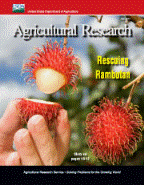United States Department of Agriculture: Agricultural Research Service, Lincoln, Nebraska

Agricultural Research Magazine
Date of this Version
1-2013
Document Type
Article
Citation
Agricultural Research January 2013
Abstract
Amino acids in orange juice may hold clues to the mostly secret, highly successful attack strategy of a powerful plant pathogen. Recent studies of these compounds may pave the way to a safe, effective, environmentally friendly way to vanquish this orchard enemy.
Known as Candidatus Liberibacter asiaticus, this microbe causes citrus greening disease, also called “Huanglongbing,” or “HLB.” (See article on page 4).
Agricultural Research Service chemist Andrew P. Breksa III and University of California-Davis professor Carolyn M. Slupsky have compared the amino acid composition of juice from commercially grown oranges. They used nuclear magnetic resonance spectroscopy to study juice from oranges grown on either HLBpositive trees or HLB-negative trees. Their investigation is apparently the first to do so, the scientists say.
The research has yielded distinctive profiles of the kinds and amounts of 11 different amino acids in 3 types of oranges: fruit from healthy trees, symptom-free fruit from HLB-positive trees, and fruit with HLB symptoms from HLB-positive trees.
With further research, the profiles may prove to be “a reliable, rapid, and early indicator of the presence of the HLB pathogen in an orchard,” Breksa says. For growers, an early indicator of HLB would be valuable. Here’s why: HLB can be a silent killer, living quietly and undetected for years in a grove of oranges, grapefruits, lemons, or other citrus fruit. The amino acid profiles may have another use, as well. They may reveal clues to mechanisms underlying the microbe’s mode of attack.
“No one understands precisely how the pathogen overcomes the defense system a citrus tree can ordinarily mobilize when it’s under siege,” Breksa says.
Trees need amino acids for growth, development, and defense. But what if the HLB pathogen were causing havoc with the trees’ ability to create, use, and recycle these amino acids?
Included in
Agriculture Commons, Animal Sciences Commons, Food Science Commons, Plant Sciences Commons

